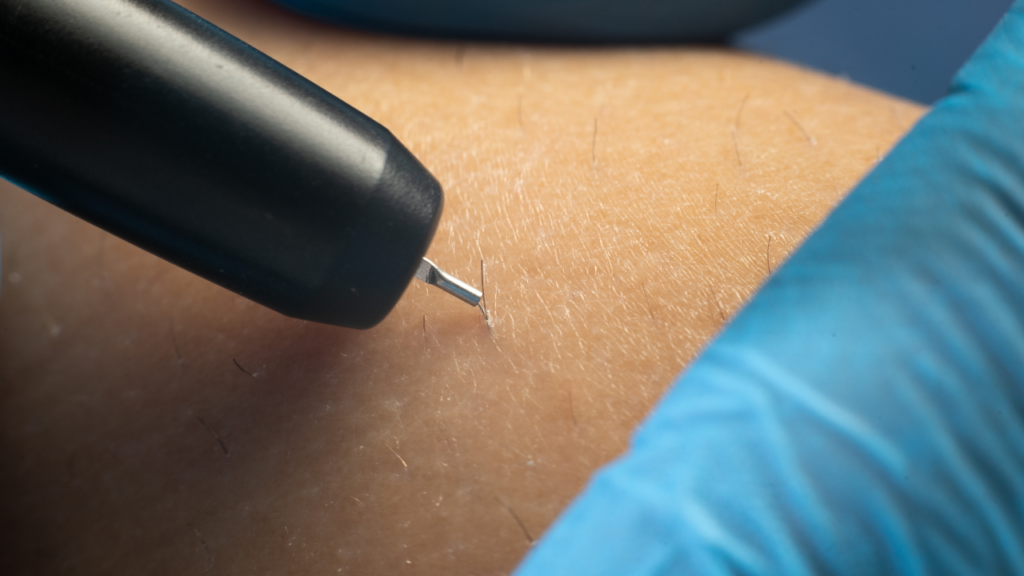Pregnancy brings many changes to a woman’s body, including increased hair growth in various areas.
With electrolysis during pregnancy safety being a primary concern, many expectant mothers seek reliable information about managing unwanted hair growth during this sensitive time.
See Also: Is Electrolysis the Future of Permanent Hair Removal?
Understanding Electrolysis
How Electrolysis Works
Electrolysis is a permanent hair removal method that uses electrical currents to destroy hair follicles.
There are three main types:
- thermolysis
- galvanic
- blend methods.
Effectiveness and Permanence
Electrolysis remains the only FDA-approved method for permanent hair removal, making it more reliable than laser treatments for long-term results.

Pregnancy and Hair Growth
Hormonal Changes
During pregnancy, hormonal fluctuations can cause increased hair growth in various body areas, particularly on the face, abdomen, and breasts.
Common Areas of Growth
Pregnancy hormones typically trigger excess hair growth on:
- Face, particularly chin area
- Abdomen
- Breasts
- Neck
Safety Considerations for Electrolysis During Pregnancy
FDA Stance
While the FDA has approved electrolysis for permanent hair removal, specific guidelines for pregnancy remain limited.
Potential Risks and Concerns
- Skin Sensitivity: Pregnancy can increase skin sensitivity
- Infection Risks: Higher susceptibility during pregnancy
- Pain Tolerance: May vary throughout pregnancy
Trimester-specific Considerations
- First Trimester: Avoid treatments due to heightened sensitivity
- Second Trimester: Most favorable time for treatment
- Third Trimester: Exercise caution, especially on abdomen and breasts
Expert Opinions and Medical Advice
Obstetrician Perspectives
Most obstetricians recommend waiting until after pregnancy to begin new electrolysis treatments.
They emphasize focusing on the safety of both mother and developing fetus.
Dermatologist Recommendations
Dermatologists often suggest postponing electrolysis during pregnancy due to increased skin sensitivity and potential scarring risks.
Electrologist Insights
Experienced electrologists emphasize the importance of:
- Individual assessment
- Modified treatment protocols
- Careful attention to skin reactions
- Proper sanitization methods
Alternative Hair Removal Methods for Pregnant Women
Waxing
While generally safe during pregnancy, waxing may cause increased skin sensitivity and potential irritation.
Threading
Threading offers a chemical-free option particularly suitable for facial hair removal during pregnancy.
Tweezing
A safe but time-consuming method ideal for small areas and precise hair removal.
Safe Depilatory Creams
Most healthcare providers recommend avoiding chemical depilatories during pregnancy due to absorption concerns.
See Also: Is Electrolysis Hair Removal permanent?
Preparing for Electrolysis if Deemed Safe
Choosing a Qualified Electrologist
Look for professionals who:
- Hold current certification
- Have specific experience with pregnant clients
- Maintain sterile equipment
- Follow strict safety protocols
Pre-treatment Considerations
Essential preparations include:
- Medical clearance from healthcare provider
- Skin patch test
- Proper hydration
- Clean skin
Post-treatment Care
Careful attention to:
- Keeping the area clean
- Avoiding harsh products
- Monitoring for adverse reactions
- Following aftercare instructions
Postpartum Hair Removal
When to Resume or Start
Most practitioners recommend waiting 6-8 weeks after delivery before starting or resuming electrolysis treatments.
Managing Pregnancy-induced Hair Growth
Postpartum hormone normalization often resolves some pregnancy-related hair growth naturally.
FAQs About Electrolysis During Pregnancy
- Is electrolysis safe during the first trimester?
Healthcare providers generally advise against first-trimester treatments due to early developmental stages.
- Can electrolysis affect the fetus?
No direct evidence suggests harm to fetal development, but caution is recommended.
- Are there long-term effects?
Research shows no documented long-term effects on mother or baby when performed properly.
- How does pregnancy affect effectiveness?
Hormonal changes may reduce treatment effectiveness during pregnancy.
- Can I use numbing creams?
Most medical professionals advise against using numbing creams during pregnancy.
Final Thoughts on Electrolysis During Pregnancy Safety
The decision to pursue electrolysis while pregnant requires careful consideration and medical consultation.
While some women successfully undergo treatments during pregnancy, others choose to wait until after delivery.
Always prioritize safety and consult with healthcare providers before making your decision.
What factors are most important to you when considering hair removal during pregnancy?
Expert Electrolysis for Expectant Mothers at Archangel Macsika Spa
At Archangel Macsika Spa in Port Harcourt, Nigeria, we understand the unique hair removal needs of pregnant women.
Our skilled electrologists offer safe and effective treatments tailored to your changing body.
Why choose us for electrolysis during pregnancy:
- Pregnancy-safe protocols: We follow strict guidelines to ensure your safety and comfort throughout each trimester.
- Customized treatments: Our experts adapt techniques to address hormonal hair growth specific to pregnancy.
- Comprehensive care: We provide pre and post-treatment advice to minimize any potential risks associated with electrolysis during pregnancy.
Ready to discuss your pregnancy hair removal options? Book a consultation today at Archangel Macsika Spa, Let’s help you feel confident and comfortable throughout your pregnancy journey.

